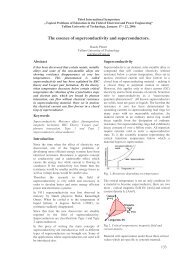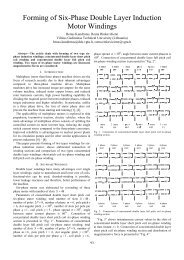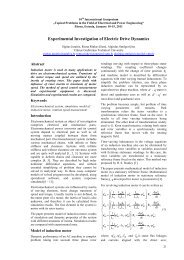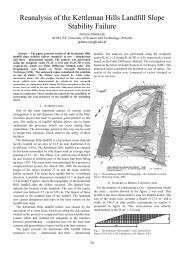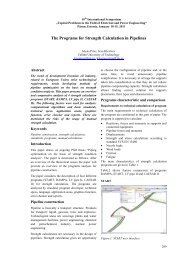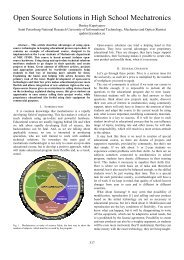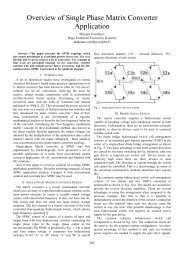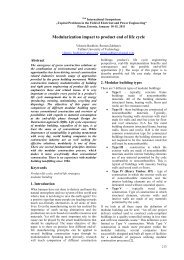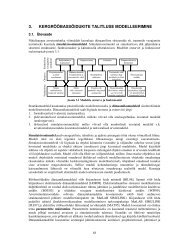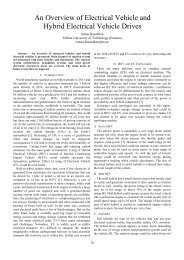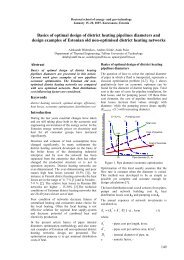New isolated converter for interfacing PMSG based wind turbine ...
New isolated converter for interfacing PMSG based wind turbine ...
New isolated converter for interfacing PMSG based wind turbine ...
You also want an ePaper? Increase the reach of your titles
YUMPU automatically turns print PDFs into web optimized ePapers that Google loves.
10 th International Symposium„Topical Problems in the Field of Electrical and Power Engineering“Pärnu, Estonia, January 10-15, 2011<strong>New</strong> <strong>isolated</strong> <strong>converter</strong> <strong>for</strong> <strong>interfacing</strong> <strong>PMSG</strong> <strong>based</strong><strong>wind</strong> <strong>turbine</strong> with distribution networkLauris Bisenieks 1,2 , Dmitri Vinnikov 1 , Ilya Galkin 2Tallinn University of Technology 1 , Riga Technical University 2lauris.bisenieks@rtu.lv, dm.vin@mail.ee, ilja.galkins@gmail.comAbstractThis paper presents a new <strong>converter</strong> topology <strong>for</strong><strong>interfacing</strong> a permanent magnet synchronousgenerator <strong>based</strong> variable speed <strong>wind</strong> <strong>turbine</strong> with aresidential power network. The theory of <strong>wind</strong>energy conversion is analyzed first. Then anexample of <strong>wind</strong> velocity distribution andnormalized energy yield is discussed in order to<strong>for</strong>mulate requirements <strong>for</strong> choosing a power<strong>converter</strong>. A new topology of an <strong>interfacing</strong><strong>converter</strong> is analyzed and simulation results of alossless model are presented. Simulation results ofthe proposed <strong>converter</strong> prove that its utilization in<strong>wind</strong> power applications is beneficial.Experimental results are given <strong>for</strong> verification ofsimulation ones.KeywordsWind energy, <strong>PMSG</strong>, qZS DC/DC <strong>converter</strong>,variable speed <strong>wind</strong> <strong>turbine</strong>sIntroductionSustainability is the main aspect that <strong>for</strong>ces therenewable energy sources to be implemented <strong>for</strong>electric energy generation instead of fossil ones.Wind energy is quite attractive among other sourcesbecause of its commercial potential [72 TW] that isfive times higher than world energy demand in all<strong>for</strong>ms. However, the installed capacity in 2009 wasonly 159 GW [1] and [2]. Large <strong>turbine</strong>s play a mainrole on the market, but there is also demand <strong>for</strong>small <strong>turbine</strong>s in the power range up to 11 kW as thepower source <strong>for</strong> micro generators.Micro generator is an electrical energy source thatincludes all interface units and operates in parallelwith the distribution network. Current rating of suchdevices is limited up to 16 A per phase [7]. Someenergy sources can be connected directly to thedistribution network, but in the case of DC powersources or variable speed <strong>wind</strong> <strong>turbine</strong> (VSWT)systems it is necessary to use a power <strong>converter</strong> thatinterfaces the source and the grid.VSWT <strong>based</strong> micro generators consist of a <strong>wind</strong><strong>turbine</strong>, a generator and an inverter. Wind <strong>turbine</strong>scapture <strong>wind</strong> energy and convert it to rotationalmechanical energy. Variable speed operation of the<strong>wind</strong> <strong>turbine</strong> allows extraction of higher energy from<strong>wind</strong> than constant speed systems [8]. The generatorconverts mechanical energy into electricity.Different types of generators can be used in <strong>wind</strong>energy conversion systems (WECS), but permanentmagnet synchronous generators (<strong>PMSG</strong>) play a mainrole on the market [9]. The main advantage of<strong>PMSG</strong> is the possibility of multipole design thatoffers slow speed operation and the possibility ofgearless WECS construction. Another advantage ismaintenance free operation since there are nobrushes. The main drawback of <strong>PMSG</strong> is thedependence of its output voltage on the rotationspeed. The difference between the minimum and themaximum voltage can reach four times in VSWTapplications [3]. This drawback can be easilyovercome with the help of an appropriate <strong>interfacing</strong><strong>converter</strong>.The <strong>interfacing</strong> <strong>converter</strong> rectifies the input AC withvariable voltage and frequency, adjusts voltagelevels and inverts DC voltage into AC with gridvoltage and frequency. Additionally, it should havemaximum power point tracking (MPPT)functionality to extract more power from <strong>wind</strong>.Different topologies of the <strong>interfacing</strong> <strong>converter</strong> arediscussed in the literature [8-19]. Basically they canbe divided into two groups: topologies withoutgalvanic isolation [16] (Fig. 1a) and those withisolation. Line frequency (LF) trans<strong>for</strong>mers (Fig. 1b)were widely used <strong>for</strong> galvanic isolation in lastdecades [19]. Main drawbacks of LF trans<strong>for</strong>mer arehigh weight and high price. For these reasonstopologies with HF isolation (Fig. 1c) have becamepopular especially <strong>for</strong> photovoltaic applications [18],but there are only few topologies <strong>for</strong> <strong>wind</strong>applications studied in the literature [10,15].All the topologies mentioned have a distinct DClink. It means that on the generator side there is arectifier, but an inverter is placed on the grid side.Some low pass filter can be added to the inverter tofulfill standard requirements. Inverters have fullbridge configuration in most cases because of lowerDC link voltage. Since the inverter is well-known,this part of the <strong>interfacing</strong> <strong>converter</strong> would not beinvestigated in this paper. The basic function of arectifier is input voltage rectification, but it can100
velocity per <strong>wind</strong> <strong>turbine</strong> modes is presented inTable 1. It shows that the <strong>wind</strong> <strong>turbine</strong> is silent onequarter of the time and half of the time works at lowspeed.<strong>PMSG</strong>s with 8 pole pairs are considered as a powersource in this research. Its line voltage is 140 V at375 rpm, but it can operate up to 510 rpm. Thisspeed is considered as the maximum poweroperational point <strong>for</strong> the <strong>turbine</strong> and the generator.Generator power reaches 1250 W at this point, butthe output voltage is 183 V.Fig. 3. VSWT power vs. rotation speed of <strong>turbine</strong> atdifferent <strong>wind</strong> velocitiesFig. 6. Output power of VSWTCut-in speed <strong>for</strong> a <strong>turbine</strong> is 125 rpm and it canproduce 20 W, but the generator voltage is only 48Vat this point. So this is the lowest input voltage <strong>for</strong> a<strong>converter</strong>. Generator speed and voltagecharacteristics are shown in Fig. 7.Fig. 4. An example of <strong>wind</strong> velocity distributionFig. 7. Generator speed and voltage vs. <strong>wind</strong> speedFig. 5. An example of normalized energy yield1.2 <strong>PMSG</strong> <strong>based</strong> <strong>wind</strong> <strong>turbine</strong><strong>PMSG</strong> <strong>based</strong> VSWTs have three distinct operationmodes: silent mode, variable speed operation modeand constant speed mode. A <strong>turbine</strong> is silent in twocases: <strong>wind</strong> speed is below a cut-in level or abovethe cut-off speed. If the speed is below its cut-inlevel it produces insufficient torque to move the<strong>turbine</strong>. At the same time <strong>wind</strong>s above the cut-offlevel may damage the <strong>turbine</strong> that must be stoppedat such conditions. A <strong>turbine</strong> usually starts to operateat 3 m/s and it should be stopped at the <strong>wind</strong> speedabove 25 m/s [3]. Turbines operate at variable speedin the <strong>wind</strong> velocity range from cut-in to rated <strong>wind</strong>speed. Rated <strong>wind</strong> speed differs by <strong>turbine</strong> types, butoften has the value of 12 meters per second.Constant speed mode takes palace above the rated<strong>wind</strong> speed. Turbine output power remains constantat this mode (Fig. 6).Table 1. Wind <strong>turbine</strong> modesWind velocityrangeNospeedSlowspeedRatedspeedHighspeed0-3 3.5-6.5 7-8 8.5-25Time 23% 46% 16% 15%Energy 0% 22% 24% 54%2 Topologies of interface <strong>converter</strong>s <strong>for</strong><strong>PMSG</strong> <strong>based</strong> VSWTInterface <strong>converter</strong> <strong>for</strong> a <strong>PMSG</strong> <strong>based</strong> VSWT canhave different topologies. Topologies with HFisolation <strong>for</strong> VSWT application already known arestudied in this section to evaluate their pros and consin the context of the described <strong>PMSG</strong> utilization insuch systems and a new interface <strong>converter</strong> topologywith qZS DC/DC <strong>converter</strong> <strong>based</strong> HF isolation isoffered.2.1 Traditional topologiesThere are only few <strong>converter</strong> topologies with highfrequency isolation <strong>for</strong> small <strong>wind</strong> applicationsstudied in the literature [10,15,18]. In [10] theauthors have proposed a buck type <strong>isolated</strong> DC/DC<strong>converter</strong> (Fig. 8a). Variable generator voltage isrectified with a three-phase diode bridge firstly intoproportional DC voltage. Stabilization of the secondDC link voltage is obtained with the buck type<strong>isolated</strong> DC/DC <strong>converter</strong> by means of duty cyclevariation. The main drawback of this solution is highcurrents in the trans<strong>for</strong>mer’s primary <strong>wind</strong>ing atrated <strong>wind</strong> speeds that will reduce <strong>converter</strong>efficiency at this operating point. In [18] the authorshave proposed a one-phase soft-switched dual LCLDC/AC <strong>converter</strong> (Fig. 8b). This <strong>converter</strong> utilizes acontrolled rectifier <strong>for</strong> generator voltage rectificationand DC link voltage stabilization. The soft-switched102
dual LCL DC/AC <strong>converter</strong> needs stable DC linkvoltage, so generator voltage should be boost up toits maximum voltage amplitude value in the wholeinput voltage range that will reduce the efficiency ofthe controlled rectifier at low generator speed.2.2 <strong>New</strong> proposed topologyTo improve the efficiency of the <strong>PMSG</strong> <strong>based</strong>VSWT system a new <strong>converter</strong> topology isintroduced, presented in Fig. 8c. It consists of athree-phase full bridge controlled rectifier (generatorside inverter) with PFC functionality and a quasi-Z-source (qZS) DC/DC <strong>converter</strong> with an HFtrans<strong>for</strong>mer <strong>for</strong> galvanic isolation. Grid sideinverters with output filters are not discussed here.A PFC inverter converts the variable voltage withvariable frequency U gen from the <strong>PMSG</strong> into astabilized DC voltage U dc1 . The qZS DC/DC<strong>converter</strong> offers galvanic isolation and voltage leveladjustment by means of the trans<strong>for</strong>mationcoefficient. The unique qZS impedance network andappropriate control offer an additional voltageregulation capability at high efficiency. StabilizedDC link voltage U out can be inverted into the gridcurrent by an appropriate inverter.3 Operating principle of the newinterface <strong>converter</strong>This research attempts to prove the ability of theproposed topology to ensure stable grid side DC linkvoltage U out . For this reason only the operatingprinciples of the controlled rectifier and the qZSDC/DC <strong>converter</strong> will be studied in more detail. Thepower circuit of the qZS <strong>based</strong> DC/DC <strong>converter</strong> isshown in Fig. 8c, but operation modes in Fig. 9.The voltage boost necessary is obtained by twosteps. The PFC rectifier stabilizes the first DC linkvoltage U dc1 to a 150 V level when the generatorvoltage is below 112 V. The DC link voltage U dc1has the following relation with the generator linevoltage U genf in the PFC mode:Udc1U=zp−pU⋅Urgenf⋅ sinωt⋅ sinωt, (4)where U zp-p is the sawtooth voltage but U r is thevalue of the reference signal amplitude.D 3 D 5Q1Q3L1T1D11D13C 1C 2U outU genD 1D2D4D6Q 4Q 2D14D12(a)(b)Controlled rectifier IinqZS DC/DCQ1 Q3 Q5Q1 Q3C2U gen L1 L2CdcUdc1U1Q 4 Q 6 Q 2D5Q 2C1Q 4TR D1D 4Cout1Cout2IoutUoutFig. 8. Interfacing <strong>converter</strong> topologies: a) with a buck type <strong>isolated</strong> DC/DC <strong>converter</strong>, b) one-phase LCLDC/AC <strong>converter</strong>, c) proposed interface <strong>converter</strong> with qZS DC/DC(c)103
The controlled rectifier works as a usual rectifierwhen the generator voltage U gen is above 112 V. Inthis mode the DC link voltage is changedproportionally to the generator voltage, at the rangefrom 150 V in rated speed conditions up to 250 V atthe maximal speed.rectifier’s ability to boost up generator voltage incut-in speed conditions.Fig. 9. Operation modes of a <strong>converter</strong>The qZS <strong>based</strong> HF isolation <strong>converter</strong> is stabilizingthe HF inverter input voltage U 1 to 250 V despite thevoltage variations on the first DC link. Thestabilized input voltage U 1 ensures inverteroperation with the fixed duty cycle, thus ensuringconstant volt second balance of the isolationtrans<strong>for</strong>mer. The input voltage U 1 regulation isobtained by changing the shoot-through duty cycle[5]. The input voltage U 1 and the first DC linkvoltage U dc1 have the following relation:UU= dc11(1 − 2 ⋅ Ds), (5)where D s is the shoot-through duty cycle. The shootthroughduty cycle is zero when the first DC linkvoltage U dc1 is equal to the necessary input voltageU 1 . In such cases the HF inverter operates withoutshoot-through states.4 Analysis of simulation resultSimulations of the controlled rectifier and the qZSDC/DC <strong>converter</strong> at different operation modes wereper<strong>for</strong>med to prove the functionality of the proposedtopology. PSIM software was used <strong>for</strong> thesesimulations. Lossless models of the controlledrectifier and the qZS DC/DC <strong>converter</strong> weredeveloped <strong>for</strong> the required simulations. Parametersof the developed models are summarized in Table 2.Table 2. Parameters of passive components of theinterface <strong>converter</strong><strong>PMSG</strong> phase resistance1 Ω<strong>PMSG</strong> inductance5 mHFirst DC link capacitance 470 µFInductors of qZS network 600 µHCapacitors of qZS network 40 µFHF trans<strong>for</strong>mer turns ratio 1.25Capacitors of voltage doubler rectifier 20 µFSimulation of the controlled rectifier was per<strong>for</strong>medat three different operating modes: minimumgenerator voltage, edge of PFC operation andmaximum speed conditions, taking into accountavailable power. Fig. 10 illustrates controlledFig. 10. Generator current I gen and rectifier outputvoltage U dc1 at U gen = 48VGenerator current is no more sinusoidal when thegenerator voltage U gen reaches 112 V (Fig. 11), butis not so distorted as in the case of pure rectifieroperation (Fig. 12). Rectifier simulation resultsshows that the voltage of the first DC link is kept inpredefined limits in all generator operation modes.Fig. 11. Generator current I gen and rectifier outputvoltage U dc1 at U gen = 112 VFig. 12. Generator current I gen and rectifier outputvoltage U dc1 at U gen = 183 VSimulations of the qZS DC/DC <strong>converter</strong> with thevoltage doubler rectifier were per<strong>for</strong>med at twodifferent modes. The first simulation was made inthe rated conditions – the first DC link voltage U dc1was 150 V and the load of the voltage doublerrectifier was 300 W. The first DC link and the HFinverter input voltage are shown in Fig. 13.Fig. 13. Voltage and currents of qZS DC/DC<strong>converter</strong> in rated conditions104
Fig. 20. Output voltage and current of voltagedoubler rectifierSecond experiment was per<strong>for</strong>med in conditions thatcorrespond to maximal <strong>wind</strong> speed. First DC linkvoltage U dc1 was set to 250 V, but load of voltagedoubler rectifier was 1250 W. Inverter input voltageU 1 have small ripple due to charge current of voltagedoubler rectifier, but qZS DC/DC <strong>converter</strong> inputcurrent I in have no ripple (Fig. 21).Fig. 23. Secondary voltage of isolation trans<strong>for</strong>merat 1250 W loadOutput voltage of voltage doubler rectifier havebigger ripple than at rated conditions (Fig. 24) andcan be too high if load will be grid inverter insteadof pure active load.Fig. 21. Input voltage U 1 of inverter and inputcurrent I in of qZS networkTrans<strong>for</strong>mer primary and secondary voltagewave<strong>for</strong>ms have the same shapes as in simulations(Fig. 22, Fig. 23).Fig. 22. Primary voltage of isolation trans<strong>for</strong>mer at1250 W loadFig. 24. Output voltage and current of voltagedoubler rectifier at 1250 W loadConclusions and Future WorkThe study of the <strong>wind</strong> theory shows that a variablespeed <strong>wind</strong> <strong>turbine</strong> allows maximum power from airflow to be extracted. <strong>PMSG</strong> <strong>based</strong> VSWTcharacteristics and <strong>wind</strong> properties on the Balticcoastal regions were analyzed to define the <strong>converter</strong>operation modes. Analysis of the <strong>converter</strong>topologies studied earlier shows that they are notwell suited <strong>for</strong> VSWT applications due to the highcomplexity of the parallel LCL DC/AC <strong>converter</strong> orlow efficiency in the case of the <strong>isolated</strong> buck type<strong>converter</strong>.For these reasons the new topology of <strong>PMSG</strong> <strong>based</strong>VSWT and grid <strong>interfacing</strong> <strong>converter</strong> is presented inthis paper. The <strong>converter</strong> consists of a fullycontrolled rectifier, a quasi-Z-source DC/DC<strong>converter</strong>, a high frequency isolation trans<strong>for</strong>merand a voltage doubler rectifier. Such topology offersgood input voltage boost properties and a relativelysimple power circuit.Simulations of the proposed topology wereper<strong>for</strong>med to verify its ability to ensure necessaryoutput voltage at all defined generator operationmodes.106
Experimental results of qZS DC/DC <strong>converter</strong> showits ability to work in defined input voltage andcorresponding load range. The capacitors of voltagedoubler rectifier should be recalculated to carry loadvariations caused by grid inverter operationThe prototype of the full <strong>converter</strong> should bedeveloped to obtain the experimental results andevaluate the qZS DC/DC <strong>converter</strong> ability to workwith grid frequency inverter.References1. Cristina L. Archer and Mark Z. Jacobson.Evaluation of global <strong>wind</strong> power, 2005.Journal Of Geophysical Research, Vol. 110.2. World <strong>wind</strong> energy association. World WindEnergy Report 2009.[online].available:http://www.w<strong>wind</strong>ea.org/home/images/stories/world<strong>wind</strong>energyreport2009_s.pdf3. Manfred Stiebler. Wind Energy Systems <strong>for</strong>Electric Power Generation. Berlin: Springer-Verlag Berlin Heidelberg, 2008. 157 p.4. Anderson, J., Peng, F.Z. Four Quasi-Z-SourceInverters, 2008 IEEE Power ElectronicsSpecialist Conference, PESC 2008, Rhodes,Greece, 2008, pp. 2743-2749.5. Vinnikov, D., Roasto, I., Zakis, J., Strzelecki, R.,<strong>New</strong> Step-up DC/DC Converter <strong>for</strong> Fuel CellPowered Distributed Generation Systems: SomeDesign Guidelines, Przeglad Elektrotechniczny,vol. 86 pp. 245-252.6. Yogesh M., Kawale Mtech, Subroto Dutt.Comparative study of Converter Topologies used<strong>for</strong> <strong>PMSG</strong> Based Wind Generation, SecondInternational Conference on Computer andElectrical Engineering, Dubai, UAE, 2009,pp. 367-371.7. Requirements <strong>for</strong> the connection of microgeneratorsin parallel with public low-voltagedistribution networks, EN 50438:2007.8. Tan, K., Islam, S. Optimum control strategies inenergy conversion of <strong>PMSG</strong> <strong>wind</strong> <strong>turbine</strong> systemwithout mechanical sensors, IEEE Transactionson Energy Conversion, vol. 19, no.2, pp. 392-399,June 2004.9. Arifujjaman, M., Iqbal, M.T., Quaicoe, J.E., Acomparative study of the reliability of the powerelectronics in grid connected small <strong>wind</strong> <strong>turbine</strong>systems, Canadian Conference on Electrical andComputer Engineering, 2009. CCECE '09,pp. 394-397, 3-6 May 2009.10.Darbyshire, J., Nayar, C.V. Modelling,simulation and testing of grid connected smallscale <strong>wind</strong> systems, Australasian UniversitiesPower Engineering Conference, 2007. AUPEC2007, pp. 1-6, 9-12 Dec. 2007.11.Pathmanathan, M., Tang, C., Soong, W.L.,Ertugrul, N. Comparison of power <strong>converter</strong>s <strong>for</strong>small-scale <strong>wind</strong> <strong>turbine</strong> operation, AustralasianUniversities Power Engineering Conference,2008. AUPEC '08, pp. 1-6, 14-17 Dec. 2008.12.Yanto, H.A., Chun-Ta Lin, Jonq-Chin Hwang,Sheam-Chyun Lin, Modeling and control ofhousehold-size vertical axis <strong>wind</strong> <strong>turbine</strong> andelectric power generation system, InternationalConference on Power Electronics and DriveSystems, 2009. PEDS 2009. pp. 1301-1307,2-5 Nov. 2009.13.Fujin Deng, Zhe Chen, Power control ofpermanent magnet generator <strong>based</strong> variable speed<strong>wind</strong> <strong>turbine</strong>s, International Conference onElectrical Machines and Systems, 2009. ICEMS2009, pp. 1-6, 15-18 Nov. 2009.14.Zhang, S, Tseng, K, Vilathgamuwa, M., Nguyen,D. Design of a Robust Grid Interface System <strong>for</strong><strong>PMSG</strong>-<strong>based</strong> Wind Turbine Generators, IEEETransactions on Industrial Electronics, no. 99,pp. 1.15.Li, X., Bhat, A., Multi-cell operation of a highfrequency<strong>isolated</strong> DC/AC <strong>converter</strong> <strong>for</strong> gridconnected<strong>wind</strong> generation applications,International Conference on Industrial andIn<strong>for</strong>mation Systems (ICIIS), 2009, pp. 169-174,28-31 Dec. 2009.16.Dehghan, S.M., Mohamadian, M., Varjani, A.Y.A <strong>New</strong> Variable-Speed Wind Energy ConversionSystem Using Permanent-Magnet SynchronousGenerator and Z-Source Inverter, IEEETransactions on Energy Conversion, vol. 24,no. 3, pp. 714-724, Sept. 2009.17.Shchur, I. Impact of nonsinusoidalness onEfficiency of alternative electricity generationsystems, International School on NonsinusoidalCurrents and Compensation (ISNCC), 2010,pp. 218-223, June 2010.18.Xiaodong Li, Bhat, A., A phase-modulated highfrequency<strong>isolated</strong> dual LCL DC/AC <strong>converter</strong>,Energy Conversion Congress and Exposition,2009, ECCE 2009 IEEE, pp. 350-357,20-24 Sept. 2009.19.Yanto, H.A., Chun-Ta Lin, Jonq-Chin Hwang,Sheam-Chyun Lin. Modeling and control ofhousehold-size vertical axis <strong>wind</strong> <strong>turbine</strong> andelectric power generation system, InternationalConference on Power Electronics and DriveSystems, 2009. PEDS 2009, pp. 1301-1307,2-5 Nov. 2009.107



